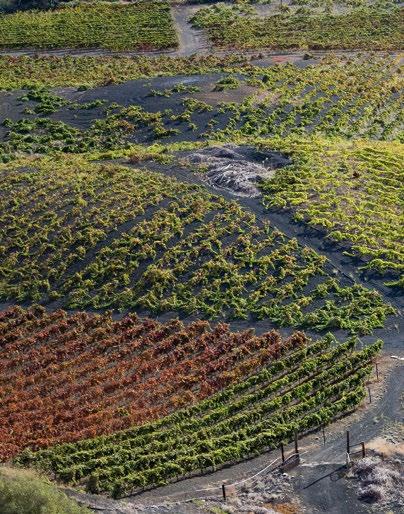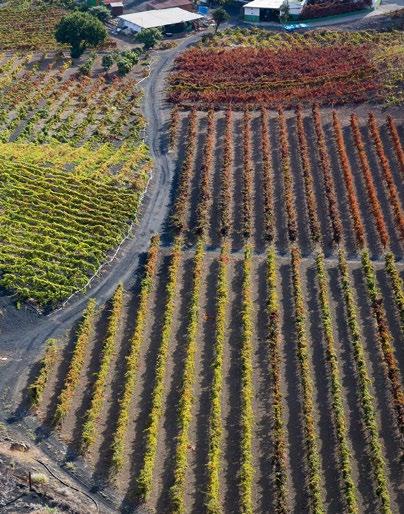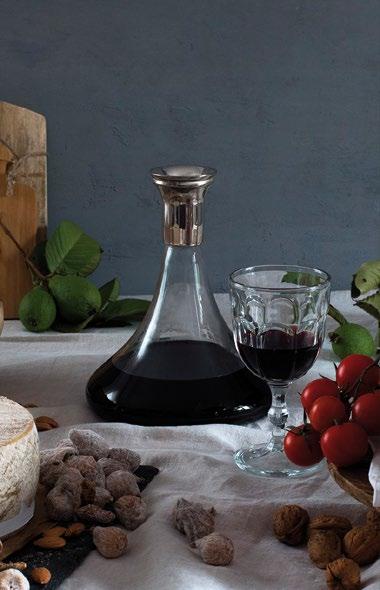
7 minute read
Wines from Gran Canaria
Grapevines were introduced into the Canaries by the Castilian Conquerors in the 15th century, and became the dominant crop. The Canary grape became famous around the world, being known as Malmsey Canary Wine, or simply Canary wine. It is worth remembering that the Canaries were a vitally important location for sailing routes between Europe and America, meaning they had access to a range of winery products from all around the world. However, a series of unfortunate historical events (competition from wines from Andalusia, a breakdown in relations with Great Britain and the appearance of desease in grapevines, among others), led to wine-making falling off considerably for over a century.

Then in the 1990s, the wine industry on the island began to recover, in the form of a small number of winegrowers in different areas, who restructured the cultivation systems that enabled new working practices and new technological advances, achieving a balance between deep-rooted tradition and cutting edge technology. Alongside this, the wine industry modernized facilities at their bodegas and improved their wine-making processes. These advancements to the sector led to improvements in the quality of production and profitability of wine in Gran Canaria. Parallel to these efforts, the Cabildo de Gran Canaria has developed different lines of research and services to farmers to bolster their efforts while helping to preserve the traditional Canary countryside.
Characteristics of Gran Canaria’s wines
The Canaries enjoy a wide range of wine varieties, and considering that the phylloxera plague didn’t affect the region, low vine stumps can still be cultivated today, without having to resort to root grafting. For this reason, unique varieties on a world level can be obtained, with all the benefits that come with it, namely plant longevity offering a great purity of wine.
Meanwhile, due to the specific climatic conditions in the Canaries, grapevines can be cultivated at altitudes ranging from 100 metres to 1,500 metres above sea level, allowing for the existence of many different varieties in a tiny territory, while obtaining grapes with different oenological characteristics out of any single variety. There are currently around 35 different varieties of vines in the Canaries.
The Denomination of Origin of Gran Canaria
The Gran Canaria designation of origin (PDO), attained in 2006 by consolidating the two that the island already had, the PDO Gran Canaria and PDO Monte Lentiscal, covers all the island’s wine-growing areas. The Regulatory Council is located in the municipality of Santa Brígida Bridget and has a total of 47 registered wineries, 37 of which are bottling. The Gran Canaria PDO protects and controls the work of its winegrowers and wineries, to guarantee the quality of the wines sold.


Commercial brands of the Denomination of Origin of Gran Canaria

AGALA Tejeda www.bodegasbentayga.com AYA Telde www.bodegahinojo.com BELIANDRA Vega de San Mateo 650 184 285 BODEGA LOS LIRIOS Las Palmas de G.C. bodegaloslirios.com BODEGA SAN JUAN Santa Brígida bodega-sanjuan.com BODEGÓN VANDAMA Santa Brígida bodegonvandama.com CALDERA Santa Brígida www.bodegahoyosdevandama.com CALETÓN Gáldar ondina@ondinasurf.com EIDAN Santa Brígida bodegasventura@gmail.com EL ARMERO Vega de San Mateo 629 312 498 EL CAPÓN Las Palmas de G.C. bodegacapon@gmail.com EL CERRILLAL Gáldar bodegasviejoanton5@gmail.com FINCA EL TRONCÓN Valsequillo joseluis.ramoscabrera@gmail.com FRONTÓN DE ORO Vega de San Mateo frontondeoro@hotmail.com GRAN MOGAREN Valsequillo mario.reyes@vinofilos.net LA HIGUERA MAYOR Las Palmas de G.C. www.lahigueramayor.com LA MONTAÑA Vega de San Mateo conjema@yahoo.es LAS TIRAJANAS San Bartolomé de Tirajana www.bodegaslastirajanas.com LAVA Santa Brígida bodegalava@gmail.com LOS BERRAZALES Agaete www.bodegalosberrazales.com LOSOYOS Las Palmas de G.C. abaezc@telefonica.net MONDALÓN Las Palmas de G.C. www.mondalon.com ORO BLANCO San Bartolomé de Tirajana secretaria@gruposantanacazorla.com PEÑA RAJADA Tejeda desdelacaldera@gmail.com PLAZA PERDIDA Las Palmas de G.C. www.bodegasplazaperdida.com
RINCÓN DEL GUINIGUADA
Santa Brígida jodesan10@gmail.com SEÑORÍO DE AGÜMES Agüimes ysantana@aguimes.es SEÑORÍO DE CABRERA Telde senoriodecabrera.com VIÑA AGUAYRO Agüimes 629 511 846 VIÑA AMABLE Gáldar vegadegaldar.com VIÑA MONTEALTO Santa Brígida jflick@grupoflick.com VOLCÁN Santa Brígida bodegavolcan@gmail.com

Types of Wine in Gran Canaria
The product of 35 different kinds of grapevines and all their possible combinations, Gran Canaria is home to a wide range of red and white wines, semi-sweet, sweet, strong and rosé wines.
Red Wines: These reds are claret, cherry, picota cherry and ruby in colour, and suggest violet hints from mid to high layers, being clean and bright in presentation. Their olfactory intensity varies from medium to very high, with aromas of red fruits, together with hints of pepper, tobacco, chocolate and so on, depending on the varieties used in their processing. In cask vintage wines these aromas blend in with hints of their oak casks (clove, liquorice, vanilla and cinnamon). Gran Canarian reds possess a great intensity in the mouth, with red fruit flavours mixed with the spices mentioned above. Their tannins are sweet, balanced and integrated within the structure of the wine, being ample and persistent.

White Wines: These are clean and brilliant wines, and pale straw yellow in colour. They possess touches ranging from greeny to gold. They present a medium to very high intensity on the nose, with aromas of tropical fruits, banana, pear, apple





and citric fruits, hints of fennel, aniseed and green tobacco, with floral hints, depending on the varieties that have gone into the wine-making process. They have an intense, structured flavour, leaving a persistent, lingering taste in the mouth.
Semi-sweet, sweet and strong wines: The visual phase to these wines goes from a straw yellow tone to amber, gold and even mahogany colour. They are clean and brilliant wines. The have a high olfactory intensity, with strong and varied aromas (peach, lychee, orange, kiwi, lemon, jasmine, rose, etc). It has a pleasant taste on the palate, with good acidity, a wide range, lightly honey-flavoured, a spark, and great persistence.
Rosé wines: These rose-coloured wines have violet tints, and are of low to mid intensity. They are clean and brilliant. They have subtle aromas with hints of strawberry, and lightly confitted red fruits. In its tasting phase, it has a pleasant flavour on the tongue, with a marked acidity, a very high intensity and has great structure.
The Gran Canaria Wine Tasting Event
This annual event has been held since 1996, and came about as a response to the demands of the wine industry and the need for their products to be recognised. In 2006 it became an Officially Recognised Contest. The objectives of the contest are to promote the quality of the wines through an organoleptic assessment, to select the finest bottled wines on the island, and to reward and highlight the hard work put in by the wine growers and bodega owners.
This is a public contest, and as such is open to any bodega on the island who belongs to and meets the requirements established at the Denomination of Origin of Gran Canaria association. The sampling session is held on a “blind tasting” basis, featuring a jury composed of a regional team of professional tasters, and habilitated by the Department of Agriculture, Livestock, Fishing and Waters of the Government of the Canary Islands.




The best WINE ON THE ISLAND obtains the GOLD MEDAL

Check out the winners of the Island Wine Sampling Contest at:
www.grancanaria.com/turismo/es/gastronomia/catas-insulares/
The Agricultural, Livestock and Fishing Markets have been operating since July 2008, and emerged as a response to a demand for a direct sales outlet for the island’s primary sector products. To this end, the Cabildo government has set up an area at its Experimental Agricultural Farm, to facilitate the showcasing and sale of products made by the island’s farmers, shepherds and fishermen, and to boost local consumption.
Facilities are opened up to the sector at least two Saturdays every month, with around 45 producers from Gran Canaria participating on each occasion.
This market offers top local products at highly reasonable prices, as it avoids intermediaries, and also serves as an information and dissemination point on many diverse aspects of the primary sector on the island and its production. Most of the products described in this publication are readily available there.









